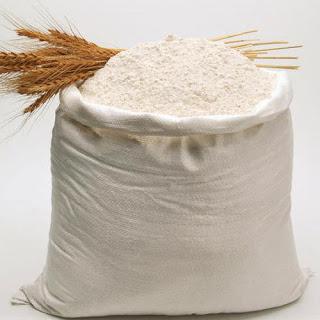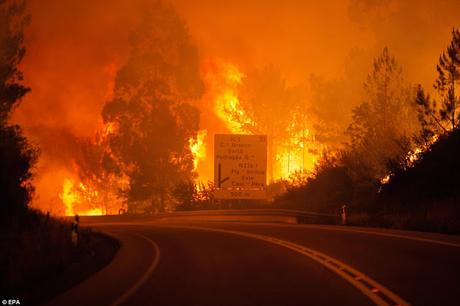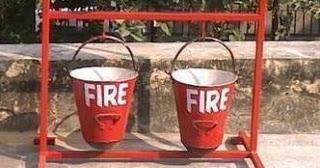 A very
general statement is : South Indians are fond of rice ~ North Indians – of wheat
(atta).
Atta is wheat flour, used to
make food items like chapathi, roti, puri .. then there is ‘maida’ finely
milled flour without bran, refined and used to make naan, paratha, bread and other food items.In making atta, whole
grains are ground to convert it into flour – this flouris further refined to separate the husk and
the bran to leave behind a very fine flour, maida.
While atta would be brown, maida is white - the endosperm part of the wheat grain. Maida is also chemically bleached to leave it
super white and very smooth. I need to
stop trying to describe something which is not my domain .. .. ..
Sadly,
there are fire accidents – arising out of various causes, most commonly
electrical short-circuit.What be the
cause, a fire accident can reduce a property to rubbles in hours~ it can cause damage to property, goods and
sometimes- fatalities and bodily
injuries to humans too.A Fire Insurance
Policy provides financial compensation for loss or damage arising out of
fire.Negligence and indifference too
contribute a big way and there are potential physical hazards of fire.
While
elimination of fire hazard entirely may not be possible, fire safety would
reduce to a large extent, the potential hazard of loss caused by fire.Fire safety measures include those that are
intended to prevent ignition of an uncontrolled fire, and those that are used
to limit the development and effects of a fire after it starts. Insurers analyze and rate the risks based on
risk potential, probability of occurrence, severity of damage and many other
factors.The method of rating special
hazards is more complex.For better
managed risks, they do offer discounts and one of the primary questions in any
proposal is about the – fire fighting equipments available and the proximity to
a Fire station.
A very
general statement is : South Indians are fond of rice ~ North Indians – of wheat
(atta).
Atta is wheat flour, used to
make food items like chapathi, roti, puri .. then there is ‘maida’ finely
milled flour without bran, refined and used to make naan, paratha, bread and other food items.In making atta, whole
grains are ground to convert it into flour – this flouris further refined to separate the husk and
the bran to leave behind a very fine flour, maida.
While atta would be brown, maida is white - the endosperm part of the wheat grain. Maida is also chemically bleached to leave it
super white and very smooth. I need to
stop trying to describe something which is not my domain .. .. ..
Sadly,
there are fire accidents – arising out of various causes, most commonly
electrical short-circuit.What be the
cause, a fire accident can reduce a property to rubbles in hours~ it can cause damage to property, goods and
sometimes- fatalities and bodily
injuries to humans too.A Fire Insurance
Policy provides financial compensation for loss or damage arising out of
fire.Negligence and indifference too
contribute a big way and there are potential physical hazards of fire.
While
elimination of fire hazard entirely may not be possible, fire safety would
reduce to a large extent, the potential hazard of loss caused by fire.Fire safety measures include those that are
intended to prevent ignition of an uncontrolled fire, and those that are used
to limit the development and effects of a fire after it starts. Insurers analyze and rate the risks based on
risk potential, probability of occurrence, severity of damage and many other
factors.The method of rating special
hazards is more complex.For better
managed risks, they do offer discounts and one of the primary questions in any
proposal is about the – fire fighting equipments available and the proximity to
a Fire station.
 forest fire in Portugal - pic credit : dailymail.co,uk
The National Fire
Protection Association (NFPA)in USA classifies
fires into five general categories (U.S.):
Class
A fires :ordinary materials like burning paper, lumber,
cardboard, plastics etc.
Class
B fires : involve
flammable or combustible liquids such as gasoline, kerosene, and common organic
solvents used in the laboratory.
Class
C fires :involve energized electrical equipment, such
as appliances, switches, panel boxes, power tools, hot plates and stirrers.
Water can be a dangerous extinguishing medium for class C fires because of the
risk of electrical shock unless a specialized water mist extinguisher is used.
Class
D fires :involve combustible metals, such as magnesium,
titanium, potassium and sodium as well as pyrophoric organometallic reagents
such as alkyllithiums, Grignards and diethylzinc. These materials burn at high
temperatures and will react violently with water, air, and/or other chemicals.
Handle with care!!
Class
K fires :are kitchen
fires. This class was added to the NFPA portable extinguishers
Standard 10 in 1998.
A fire
extinguisher, is an active fire protection device used to extinguish or control
small fires, often in emergency situations. As we all know, Fire needs“oxygen, heat and fuel” and primarily fire
extinguishers put out fire by taking awayone or more elements of the fire triangle.As stated above, there are various types of fire – say of wood, cloth,
plastics; oil, gas, flammable liquids; electrical and the like.Depending on the type of fire, the
extinguishers also vary – there are : water and foam fire extinguishers;
equipments using Carbon Dioxide; dry chemicals; wet chemicals; dry powders and
many other agents.
In some industries,
hydrant systems are installed, but more simpler are hand appliances.As a measure of safety, the primary
requirement would be at leasttwo
extinguishers in every area/ room, distributed over the entire floor that they
are available within 15 meters. One 9 liter water / sand bucket is to be provided for every 100
square meter of floor area and one 9 liter water type extinguisher is to be
provided for every six buckets or part thereof with a minimum of one extinguisher
and two buckets per compartment of the building.
In old theatres,
one would have observed brightred
coloured buckets containing sand and water..a fire bucket is a bucket
filled with water or sand which is used to prevent or extinguish fires. Often they have a convex, protruding bottom.
The rounded bottom results in a strong, directed stream of water when the
material inside is thrown at the fire. Fire buckets are a low-technology method of
fighting small fires. Although largely superseded by more modern forms of
firefighting equipment, they retain some distinct advantages and remain the
preferred method for fighting small fires in certain situations. The main
advantages of fire buckets are that they are cheap, reliable, easy to use and
can be quickly refilled and reinstated. The fundamental thing is to keep them
in reach – and more importantly keep them filled with sand (or water) – with 4
of them hanging in a row, one should remain empty and at a given periodicity,
the sand from should be transferred to the next – to ensure that sand is free
flowing and is not clogged !
When the sand in
the bucket is dumped on the fire to starve it of the oxygen it needs to stay
alight. The sand from a fire bucket can
also be used to absorb spills of flammable liquids and render them less
dangerous, by reducing the risk of ignition and explosion. Fire buckets are
often provided at petrol filling stations to absorb any small fuel spills.Now read this
interesting type of fire extinguisher !
forest fire in Portugal - pic credit : dailymail.co,uk
The National Fire
Protection Association (NFPA)in USA classifies
fires into five general categories (U.S.):
Class
A fires :ordinary materials like burning paper, lumber,
cardboard, plastics etc.
Class
B fires : involve
flammable or combustible liquids such as gasoline, kerosene, and common organic
solvents used in the laboratory.
Class
C fires :involve energized electrical equipment, such
as appliances, switches, panel boxes, power tools, hot plates and stirrers.
Water can be a dangerous extinguishing medium for class C fires because of the
risk of electrical shock unless a specialized water mist extinguisher is used.
Class
D fires :involve combustible metals, such as magnesium,
titanium, potassium and sodium as well as pyrophoric organometallic reagents
such as alkyllithiums, Grignards and diethylzinc. These materials burn at high
temperatures and will react violently with water, air, and/or other chemicals.
Handle with care!!
Class
K fires :are kitchen
fires. This class was added to the NFPA portable extinguishers
Standard 10 in 1998.
A fire
extinguisher, is an active fire protection device used to extinguish or control
small fires, often in emergency situations. As we all know, Fire needs“oxygen, heat and fuel” and primarily fire
extinguishers put out fire by taking awayone or more elements of the fire triangle.As stated above, there are various types of fire – say of wood, cloth,
plastics; oil, gas, flammable liquids; electrical and the like.Depending on the type of fire, the
extinguishers also vary – there are : water and foam fire extinguishers;
equipments using Carbon Dioxide; dry chemicals; wet chemicals; dry powders and
many other agents.
In some industries,
hydrant systems are installed, but more simpler are hand appliances.As a measure of safety, the primary
requirement would be at leasttwo
extinguishers in every area/ room, distributed over the entire floor that they
are available within 15 meters. One 9 liter water / sand bucket is to be provided for every 100
square meter of floor area and one 9 liter water type extinguisher is to be
provided for every six buckets or part thereof with a minimum of one extinguisher
and two buckets per compartment of the building.
In old theatres,
one would have observed brightred
coloured buckets containing sand and water..a fire bucket is a bucket
filled with water or sand which is used to prevent or extinguish fires. Often they have a convex, protruding bottom.
The rounded bottom results in a strong, directed stream of water when the
material inside is thrown at the fire. Fire buckets are a low-technology method of
fighting small fires. Although largely superseded by more modern forms of
firefighting equipment, they retain some distinct advantages and remain the
preferred method for fighting small fires in certain situations. The main
advantages of fire buckets are that they are cheap, reliable, easy to use and
can be quickly refilled and reinstated. The fundamental thing is to keep them
in reach – and more importantly keep them filled with sand (or water) – with 4
of them hanging in a row, one should remain empty and at a given periodicity,
the sand from should be transferred to the next – to ensure that sand is free
flowing and is not clogged !
When the sand in
the bucket is dumped on the fire to starve it of the oxygen it needs to stay
alight. The sand from a fire bucket can
also be used to absorb spills of flammable liquids and render them less
dangerous, by reducing the risk of ignition and explosion. Fire buckets are
often provided at petrol filling stations to absorb any small fuel spills.Now read this
interesting type of fire extinguisher !
 Following a major
fire at a restaurant in Kamala Mills last December, Mumbai’s hotels have been
under pressure from municipal authorities to get their act together with regard
to fire safety norms. The Hindu reports that the Indian Hotels and Restaurants
Association (AHAR) requested that it be
allowed to use ‘roti atta’ (flour) instead of sand to
tackle the initial stages of a kitchen fire.
The Fire Brigade
requires restaurants to stock sand in their kitchens to help quell any
incidents of fire. But the hoteliers have pointed out that keeping sand in the
kitchen is a violation of Food Safety and Standards Authority of India (FSSAI)
norms. In a letter to the Brihanmumbai Municipal Corporation (BMC) Commissioner
Ajoy Mehta, on January 31, AHAR has requested that they be allowed to use ‘roti
atta’ within the kitchen since, under FSSAI rules, sand cannot be stored in the
cooking area, ostensibly to avoid food contamination. Also, restaurant kitchens
stock up on flour anyway. The letter
states that they have been following the guidelines issued by the civic body,
but would like to make certain suggestions with regard to fire safety. AHAR
president Santosh Shetty said: “Old methods are okay and we are not against
using sand. It is already there. But keeping sand in the kitchen is in violation
of food contamination rules. What we are suggesting is an alternative source,
since ‘atta’ is available in every kitchen.”
“Using
flour to fight a fire is the stupidest idea I’ve ever heard,” said a professor
from IIT-Bombay. “Flour becomes a combustible gas.”However, Sunil Keswani, a plastic surgeon and
medical director of the National Burns Center in Airoli, said flour might be a
good substitute for sand for curbing kitchen fires induced by oil.
Interesting
!!
With regards – S.
Sampathkumar
10th Feb
2018.
Following a major
fire at a restaurant in Kamala Mills last December, Mumbai’s hotels have been
under pressure from municipal authorities to get their act together with regard
to fire safety norms. The Hindu reports that the Indian Hotels and Restaurants
Association (AHAR) requested that it be
allowed to use ‘roti atta’ (flour) instead of sand to
tackle the initial stages of a kitchen fire.
The Fire Brigade
requires restaurants to stock sand in their kitchens to help quell any
incidents of fire. But the hoteliers have pointed out that keeping sand in the
kitchen is a violation of Food Safety and Standards Authority of India (FSSAI)
norms. In a letter to the Brihanmumbai Municipal Corporation (BMC) Commissioner
Ajoy Mehta, on January 31, AHAR has requested that they be allowed to use ‘roti
atta’ within the kitchen since, under FSSAI rules, sand cannot be stored in the
cooking area, ostensibly to avoid food contamination. Also, restaurant kitchens
stock up on flour anyway. The letter
states that they have been following the guidelines issued by the civic body,
but would like to make certain suggestions with regard to fire safety. AHAR
president Santosh Shetty said: “Old methods are okay and we are not against
using sand. It is already there. But keeping sand in the kitchen is in violation
of food contamination rules. What we are suggesting is an alternative source,
since ‘atta’ is available in every kitchen.”
“Using
flour to fight a fire is the stupidest idea I’ve ever heard,” said a professor
from IIT-Bombay. “Flour becomes a combustible gas.”However, Sunil Keswani, a plastic surgeon and
medical director of the National Burns Center in Airoli, said flour might be a
good substitute for sand for curbing kitchen fires induced by oil.
Interesting
!!
With regards – S.
Sampathkumar
10th Feb
2018.

